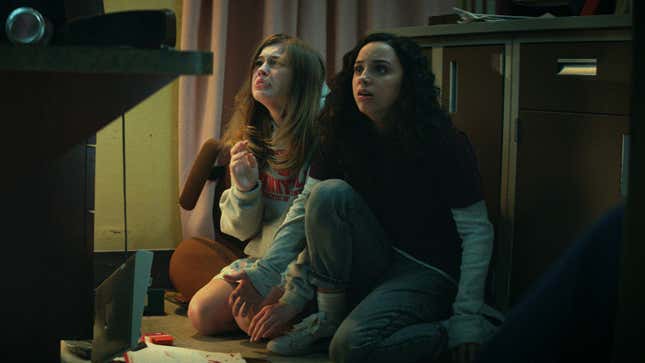Fear Street Has the Warm Fuzzies for Teens Getting Hacked Up
The slasher movie is back from the dead once more in Netflix's latest offering
EntertainmentMovies

Forward through Leigh Janiak’s Fear Street Part 1: 1994 (debuting Friday on Netflix), stop on any random scene, and inevitably you’ll spot a reference if you have even a rudimentary knowledge of recent horror movie history. Sometimes you don’t even need that—the characters are prone to calling them out for you. Stumbling on the old bones of a disturbed spirit’s grave? Classic Poltergeist move. Spilled blood turning one into monster bait? That’s Jaws, baby. There are echoes of Halloween’s besieged babysitters, Halloween 2‘s hospital setting, and Friday the 13th’s camp-slaying mayhem (though that one will play out more explicitly in Fear Street Part 2: 1978, which drops next week).
Reminiscent of Scream, there’s a similar thrill that runs through the Fear Street characters over their proximity to slayings (“That dude was wearing a Halloween skull mask. How is that not fun?,” asks one Fear Street character about a murder). And on and on it goes in a movie that’s more inclined to contextualize itself alongside genre favs rather than twist the form or improve on the classics it references. It lays some through lines so as to make the vintage relevant (the neon store signs in a darkened mall that is the site of the movie’s first murder give the picture the kind of neon teen aesthetic as seen in Spring Breakers, Euphoria, etc.). But none of it is particularly belabored. I got the feeling watching Fear Street Part 1: 1994 that it’s just happy to be here. Its joy is contagious.
Fear Street Part 1: 1994′s protagonist Deena (Kiana Madeira) is gay without pathos—she’s heartbroken in the wake of a breakup with Sam (Olivia Scott Welch) but she and the racially diverse peers with whom she interacts are sanguine about her sexuality. It isn’t an issue; Fear Street isn’t interested in pandering to progressive Twitter. This would be extraordinary and worthy of comment in 1994, when the movie is set, but it plays well from a contemporary viewer’s perspective, make-out scene and all. Sprinkled in the plot is some light commentary on the prison carceral system, as well as the notion that drug-dealing does not make someone evil (Deena’s friend Kate, played by Julia Rehwald, is a valedictorian, club president, cheerleader, pill-pusher, and decidedly not one of the movie’s monsters).
Fear Street Part 1: 1994‘s most notable social concern is class strife—the town of Shadyside, as originated in the R.L. Stine young adult book series this movie is adapting, is economically depressed and—even worse—a murder capital. “It ain’t a tragedy when it happens every week. It’s a joke,” says a bully from the tony neighboring town Sunnyvale. But that joke isn’t funny anymore to the suffering residents of Shadyside. “It happens in Shadyside over and over. People keep turning into psychos,” says one character. The reason for this, it turns out, is the curse of an old witch named Sarah Fier (pronounced “fear”), who has effectively summoned a legion of un-killable killers to avenge her burning. The characters of Fear Street Part 1: 1994 contend not with one central monster figure, but several. The movie gestures at the idea that class can be a curse.
Our heroes are sharp without being obnoxious about it. They are particularly adept at uncovering the inexplicable supernatural phenomena that is plaguing them, thanks mostly to the local-history knowledge of Deena’s “witch nerd” brother Josh (Benjamin Flores Jr.). As their ghost antagonists multiply, their strategy intensifies, and they rush from gravesite to empty high school to off-hours grocery store. That last location allows the opportunity for the movie’s most innovative and goriest death scene. I’ve never seen a bread slicer do that before.
The violence is brutal, but the shots don’t linger. The sex is implied. The dialogue doesn’t shy away from “fucks” but they don’t dominate the script, either. All together, Fear Street Part 1: 1994 has a soft-R nature. It doesn’t pull any punches, but it isn’t donning brass knuckles, either.
Things move at such a clip that the athletic pacing seems as vital to the fun as the story itself, which is ultimately yet another way to put teens in peril, this time told via sensory bombardment. At heart, Fear Street Part 1: 1994 is just a slasher movie. The acting is more natural than you might expect in the genre, the jokes are often drier, and the monsters are more numerous, but this is all ornamental. The movie isn’t trying to be anything that it isn’t, it’s just trying to pack in as much as possible to make what it actually is enticing. That’s not a radical idea, and yet what a breath of fresh air.